The Most Unique Celebrations of the New Year Across the Globe
November 17, 2024

New Year’s Eve is a time of joy, reflection, and celebration. While some cultures might celebrate the arrival of the New Year in similar ways, many societies around the world have developed their own distinctive customs and rituals to ring in the new year. In this article, we will explore some of the most unique and fascinating New Year celebrations across the globe, each with its own history, significance, and flavor.
1. Hogmanay – Scotland
In Scotland, the New Year is known as Hogmanay, and it is celebrated with remarkable fervor and enthusiasm. This festival, which dates back to the Viking influence in Scotland, emphasizes community and tradition.
– On December 31st, festivities include street parties, fireworks, and concerts.
– A key element of Hogmanay is the tradition of first-footing, where the first person to enter a home after midnight is expected to bring good luck. A tall, dark-haired man is considered the best first-footer.
– Many also enjoy a warm drink called ‘Whiskey’, and traditional foods like haggis, neeps, and tatties are served.
2. New Year’s Festival – Japan
In Japan, the New Year celebration, or Shōgatsu, encompasses several days and multiple customs that reflect the country’s rich traditions.
– Families clean their homes, pay off debts, and make peace with relatives to start the new year fresh.
– One of the most significant practices is the eating of toshikoshi soba (buckwheat noodles) on New Year’s Eve, symbolizing a long and healthy life.
– On New Year’s Day, families visit shrines to pray for good fortune, and children often receive money gifts in decorated envelopes.
Songkran – Thailand
Thailand celebrates the New Year during the Songkran festival, which occurs in mid-April. This water festival symbolizes purification and the washing away of sins.
– It is characterized by lively street parties and the widespread practice of water fights, where locals and tourists alike splash water on one another.
– People visit temples to pour water over Buddha statues, symbolizing purification and good fortune.
– Traditional foods, music, and cultural performances are a big part of the festivities.
Diwali – India
Though popularly known as the Festival of Lights, Diwali is celebrated as the New Year in several parts of India, particularly among Hindus and Jains.
– The festival usually occurs between October and November and lasts for five days.
– It symbolizes the victory of light over darkness and good over evil, marked by the lighting of oil lamps, fireworks, and exchanging sweets.
– On the last day of Diwali, known as Bhai Dooj, sisters pray for the long life and well-being of their brothers.
Lunar New Year – China
The Lunar New Year, also known as the Chinese New Year, is marked by elaborate celebrations filled with traditions and symbols for good fortune and prosperity.
– The festivities generally last for 15 days, culminating in the Lantern Festival. The celebrations begin with a family reunion dinner, where various symbolic dishes are served.
– Exchanging red envelopes containing money, or ‘hongbao’, is a common practice among family members and close friends.
– The vibrant parades showcasing dragon dances and fireworks symbolize warding off evil spirits and welcoming good fortune.
Burning of the Old Man – Peru
In Peru, a unique tradition known as “El Año Viejo” (the Old Man) involves making an effigy to symbolize the outgoing year.
– Communities create life-sized dolls, often stuffed with fireworks and old clothing, which represent the mistakes, grievances, and bad memories of the past year.
– As midnight approaches, these dolls are burned in grand displays of fireworks and celebration, symbolizing moving forward into the new year unburdened by negativity.
New Year in the Streets – Brazil
In Brazil, the New Year, known as Réveillon, is celebrated with lively parties that often take place on the beaches.
– Many wear white as a symbol of peace and renew their wishes for the upcoming year.
– At Copacabana Beach, thousands of people gather to watch fireworks, offer flowers to the sea goddess Yemanjá, and enjoy live music and dance.
– Festivities are filled with vibrant colors, energetic music, and dazzling performances, making it a unique celebration unlike any other.
Conclusion
Each region of the world brings its own flair and tradition to New Year’s celebrations, demonstrating the remarkable diversity of human culture. Whether it is through rituals of cleansing, community gatherings, or jubilant festivities, the essence of these celebrations is universal—the desire for renewal, hope, and joy. Exploring these unique customs offers us a glimpse into the heart of different societies while also celebrating our shared pursuit of a brighter future. As we step into the New Year, may we embrace these traditions, drawing inspiration from them to create our own meaningful celebrations.
As we look forward to another year filled with opportunities for joy and growth, let’s cherish the beauty of our differences, and find ways to celebrate together, drawing from the best of cultures around the world.






